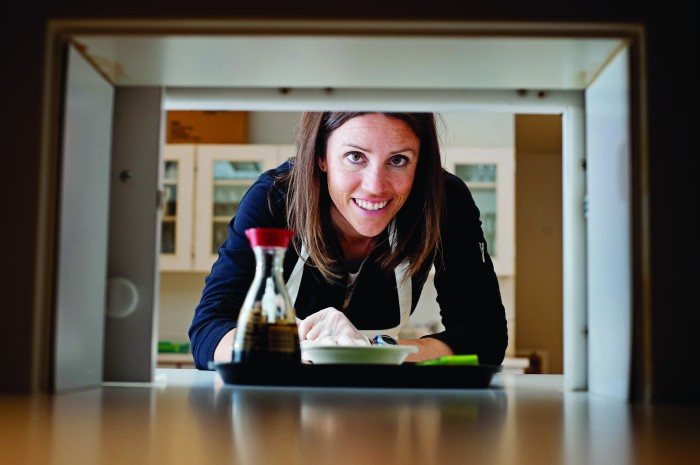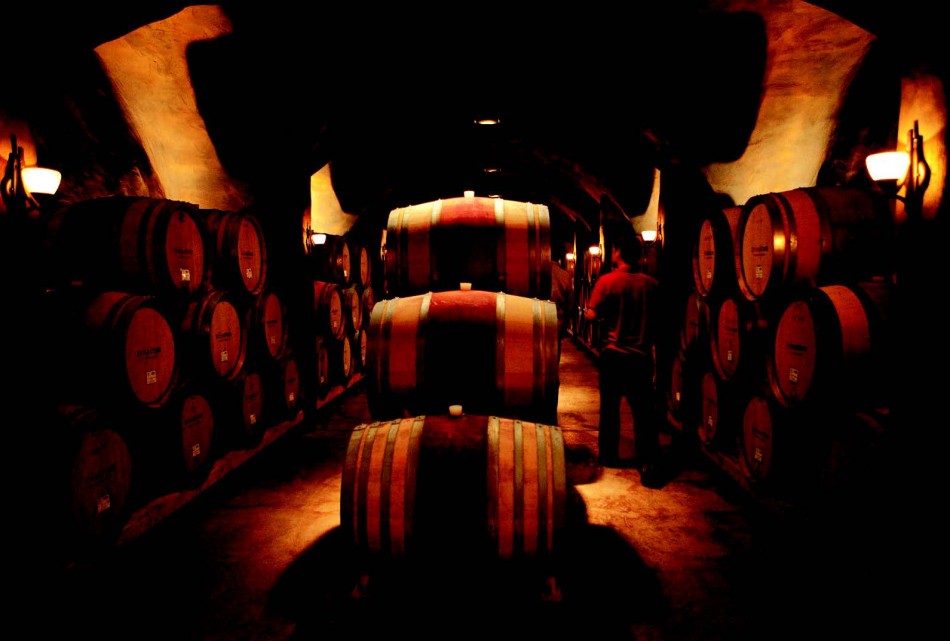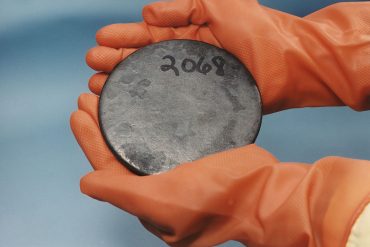Somewhere between living in France, mastering Julia Child’s ‘Turducken’ and earning degrees in biochemistry, chemistry and mathematics, Ann Colonna made a life-change that blended her love of science and food.
Stanford, Duke, Notre Dame and the University of Washington had already offered full scholarships to the All-American track star from Eugene’s Sheldon High. In the end, a sunny University of Arizona beckoned, and there the long-distance
runner graduated with honors from a grueling pre-med program. “Just for fun” before medical school, Colonna indulged
her love of baking and enrolled in a six-month culinary arts school that straddled Boulder, Colorado and Provence, France.
While meticulously creating exquisite petite fours and soufflés, something happened. Now Colonna is one of a small breed of experts known as sensory scientists. Simply put, Colonna studies what we like to eat and why.
Colonna manages the Oregon State University Sensory Science Program at the Food Innovation Center. The gleaming, modern facility in Northwest Portland is one of only two such off-campus, university experiment stations in the nation. Its
mission is to promote research and market opportunities for Oregon food and agriculture producers, and to conduct testing
for local and national companies. Colonna has built an enviable databank of 13,000 testers, a group that companies all over
the nation come to access. What these unusually discriminating testers see, smell, taste, feel, even hear inside the sensory
science lab can make or break companies and brands.
You’ve gone from studying what mosquitoes eat in biochemistry classes to studying what people eat. How does your biochemistry background help you as a sensory scientist?
Of course all those science classes are helpful and necessary when getting a graduate degree in food science. We are required to have taken courses in chemistry including organic and physical chemistry, biochemistry, mathematics, statistics, physics, microbiology, nutrition, food chemistry, food engineering and food microbiology just to be a candidate. Sensory science strongly relies on statistics and psychology as well as all the core food science courses. So, at times, outsiders will observe a sensory test and believe that it is a simple setting up of samples for people to taste and asking them to give their opinions. Nothing could be further from the truth. This is a process that requires a clear understanding of each test’s objective, use of the proper methodology, analysis and reporting. We have lighting, serving guidelines and product coding.
Multibillion dollar companies and local startups test their products here to find out what Portlanders think about their products. Why Portland?
Portland has an excellent population of people who are interested in FLOSS (fresh, local, organic,sustainable and seasonal). When it comes to certain product categories, companies will pay large amounts of money to get the opinions of these consumers. Many people in Portland are very knowledgeable and passionate about food. This is both a strength and weakness to us in Portland. I once had a company tell me at the end of a focus group session that they were surprised at how concerned these consumers were about reading labels and knowing where their food was coming from.
Take us through a typical testing session and what the companies want to know.
As a taste-tester, we invite people to sit down in a testing booth, which has a small window and computer. We pass samples back and forth through the window and ask people to give their feedback using our data acquisition system. We use different types of questions to get at our objectives: nine-point hedonic category scale questions labeled from “like
extremely” to “dislike extremely,” five-point “JAR” (just about right) scales from “too strong in an attribute” to “not strong enough,” purchase intent questions, product expectation and usage questions—the list goes on. We want them to use all of their senses to evaluate these products. That could mean smelling sashimi for aromas of the sea or crunching down on a potato chip for texture appropriateness. We want to know what drives product-liking and if people are willing to buy these products.
Any kitchen horror stories you can share?
The most challenging tests are those with products that are difficult to prepare. We always request that our client be on site to oversee the all-important product preparation. They know exactly how each item should look and taste. The key is making all 120 samples uniform—each consumer should see exactly the same thing. When you are cooking ground beef patties for more than 100 people, it can be difficult. We often bring in trained chefs to manage the kitchen for difficult projects. The raw material must be weighed and cooked to the same temperature. Everything must be planned ahead of time. The horror comes into play when things don’t go according to plan. One time we blew a fuse using too many microwaves at once (nine) and lost power for part of the test. You can’t put the test on hold because the consumers just keep coming and coming—usually ten every half hour. If the product is not ready, the panelists must be paid and sent away without participating. Another time, all ten of our computers went down at once because of an antivirus update. This shut the whole test down for that particular session. These are the things that drive you crazy as a sensory scientist.
Testers are sometimes taken back to a room that looks like something out of the TV series, “The Closer.” What happens in there?
Ohhhhh, the dreaded focus group room. Actually we give each group an introduction as to what they can expect before participating. We try to make them feel as comfortable as possible and let them know they can leave at any time. Often we find that after the first five minutes, the groups forget they are being recorded and begin to talk freely and give their opinions. That is what we are paying them for after all. We look for people who feel comfortable in this type of group setting. A moderator leads the ninety-minute discussion about product concepts or consumers’ opinions on products they have just tried in a taste test. Focus groups are yet another tool for the sensory scientist.
You don’t just test food here. You’re also a boutique business incubation center. How does that work?
We have a team of product developers, a packaging specialist, an economist, as well and the Oregon Department of Agriculture’s Development and Marketing Division and Export Services Laboratory. It is a great team of people dedicated to advancing Pacific Northwest foods. An example of helping new businesses get their feet on the ground and a product out the door is Marie Osmunson and Chez Gourmet. Marie started out with an idea and with strong encouragement from her family and friends, began a small food business, Chez Gourmet. Her idea was a veggie burger based more on local vegetables than soybeans and she worked with Sarah Masoni, product development manager at the FIC.They worked together on formulation, packaging and nutritional labeling, helping Marie gain confidence that she could market her product. Marie began small, selling to local grocery stores such as Zupan’s and was basically a two-person operation working a few days a week out of a small kitchen facility. Then everything changed when Burgerville (thirty-nine stores) needed a replacement for their veggie burgers. Burgerville liked Marie’s product in Zupan’s and asked Marie if she could increase her production from 2,000 a week to 2,000 a day. Somehow she made it work and Chez Gourmet moved into a 12,000-square-foot production facility in Wilsonville with six employees. The story continues as she soon will be supplying large retail markets on the West Coast.
Tell us about some of your most successful graduates.
As most of the work I do is proprietary and highly confidential, I can’t discuss most of the products we work on, but recently we worked with a fisherman out of Coos Bay, Oregon who is producing a “canned” albacore product, but in a pouch. Sea Fare Pacific is a fantastic product that is now sold in Market of Choice and other local specialty shops. His product was preferred two to one over the national brand we tested, and because it is only cooked once, it retains six times more Omega 3s than most brands that are twice cooked in the can.
You have an education component, being affiliated with OSU. What classes and workshops are available for the public?
A two-part entrepreneur product development seminar is offered on Friday afternoons twice a month. Part one addresses product formulation, nutritional labeling and food safety and part two addresses product packaging, processing and shelf
stability. The seminars include lecture and hands-on activities familiarizing students with basic food product development. These seminars are for anyone interested in developing a home recipe to sell to the market. We also conduct a day-long hands-on sensory methods workshop through OSU extension a few times a year.
What do you bake when you’re not working in the Food Innovation Center kitchen?
Oh, I love to bake. Just last night, I made some sweet potato biscuits with local sweet potatoes purchased from the Portland Farmers Market. My favorite cookbook is Baking with Julia. I haven’t come across one bad recipe, and I’ve made almost every one. Every August, I bake the vanilla chiffon chocolate mousse cake for my husband’s birthday. It’s the best!










What a incredible woman!
We agree!
She is perfect I think! I like the interview a lot